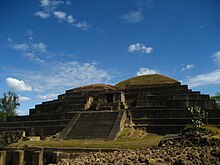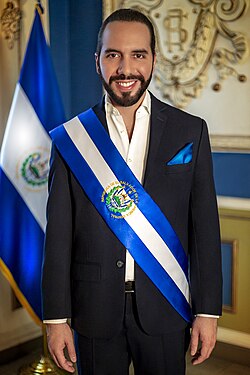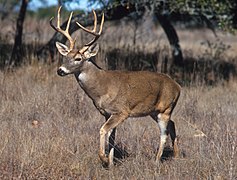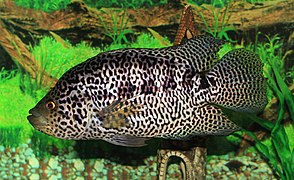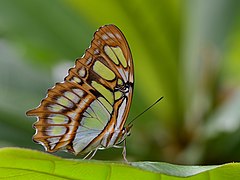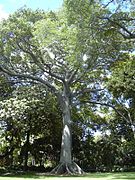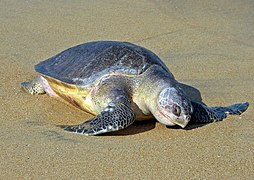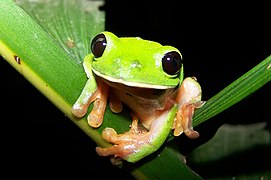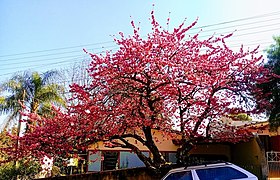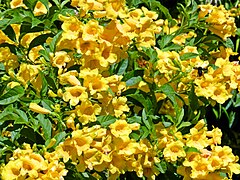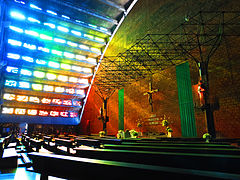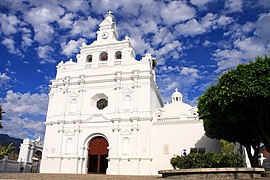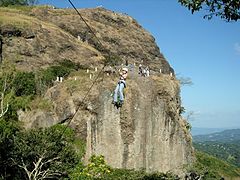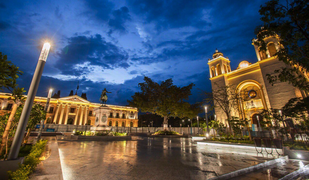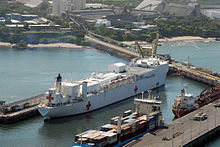The Savior
El Salvador, officially the Republic of El Salvador, is a sovereign country in Central America located on the Pacific Ocean coast with a land area of 21,041 km². In 2021 it had an estimated population of 6,486,023 inhabitants according to an estimate made by the General Directorate of Statistics and Censuses in the company of ECLAC, due to its approximate demographic density of 300 inhabitants/km² it is the most densely populated country of the American continent, not including some islands in the Caribbean Sea. Its climate is warm tropical but due to the geographical contrast the climate can vary. El Salvador borders Guatemala to the west and Honduras to the north and east, to the southeast the Gulf of Fonseca separates it from Nicaragua, and flanked to the south by the Pacific Ocean. Its territory is organized into 14 departments, 35 districts and 262 municipalities. The city of San Salvador is the capital of the country; its metropolitan area includes 14 nearby municipalities, and concentrates the political and economic activity of the republic. The cities of San Miguel and Santa Ana are other important centers of the country.
The current territory of El Salvador includes what was formerly the Mayor of Sonsonate and what was the Municipality of San Salvador that made up most of the territory. Both provinces acquired their independence from Spain in 1821 together with the Captaincy General of Guatemala and in 1824 they joined to form the "State of El Salvador", as part of the Federal Republic of Central America. In pre-Columbian times, there was an important indigenous nucleus known as the Señorío de Cuzcatlán (which in the Nahuat language means 'place of jewels' or 'place of necklaces').
From its independence until late in the 1920s, El Salvador was ruled by conservatives and liberals. However, it would not be until the 1930s that the Armed Forces would concentrate political power with the support of the local oligarchy, until the end of the 1970s, when a coup d'état ended that stage of national history. A civil war, which ran from 1980 to 1992, resulted in the deaths of an estimated 75,000 inhabitants. This war culminated when the government and the guerrillas signed peace agreements in 1992, this agreement gave way to military, social and political reforms in the country.
Later, for 30 years, political power was exercised by the ARENA and FMLN parties, who as the years passed would lose popular support due to their involvement in serious cases of corruption. This led to Nayib Bukele assuming the presidency in 2019, breaking with bipartisanship.
Toponymy
During the Conquest of America and more specifically, during the conquest of what is now Salvadoran lands, a series of fights were carried out against the natives of the place, to later found Spanish populations that were in charge of keeping the region dominated. After the conquest of Tenochtitlán, Hernán Cortés sent the Alvarado clan under the command of Pedro de Alvarado to subdue the southern regions of the Aztec Empire. The first region to be conquered were the territories that now make up Guatemala. While there, Pedro de Alvarado decided to venture into the lands of the East, territories that were subject to a kind of vassalage of the Señorío de Cuzcatlán. There, the Iberians and their allies, the so-called "friendly Indians", met brave settlers who made bloody fronts against the invaders, as occurred in the battle of Acajutla, as well as in the battle of Tacuzcalco and the battle of Cuzcatlán. All this happened in 1524. Pedro de Alvarado's commitment to subdue the natives of these lands was unsuccessful, he returned to the recently founded Guatemala City.
The following year, in 1525, Pedro de Alvarado sent a group of Spaniards under the command of Gonzalo de Alvarado with express orders to found a town on these lands with the name of San Salvador, to control the natives of the place. However, the following year, due to the resistance of the locals, the ephemeral Villa de San Salvador is depopulated and its neighbors returned to Guatemala. It would not be until 1528 that the Villa de San Salvador was refounded in the Bermuda Valley, 8 km south of the indigenous town of Suchitoto. Around 1540, the Mayor of San Salvador was created. By then there was already another population of Spanish origin in the region, San Miguel de la Frontera. The headquarters of the authorities of the Mayor's Office would be established in Villa de San Salvador. The aforementioned Mayor's Office would cover a large part of what is now the Salvadoran nation, with the exception of the now departments of Ahuachapán and Sonsonate. With this, the territory would begin to be identified with the name of the province of San Salvador. Here are the original beginnings of the name of this republic.
Centuries later, with the implementation of the Bourbon Reforms in America, intendancies would be created. These were well-defined political-administrative entities with highly strengthened authority. The former Mayor of San Salvador would become the Mayor of San Salvador in 1785 with its capital in the city of San Salvador. The creation of this intendancy will be very important for the future consolidation of the idea of a Salvadoran nation, since it allowed the San Salvadoran elites to have a particular conscience or identity, independent of Guatemala, which was viewed with suspicion.
Around 1821, in the territory of the Municipality of San Salvador, the province of San Salvador was created, officially so called, now completely independent from Guatemala. This was the product of the restoration of the constitutional regime in Spain, which decreed that all municipalities would become completely independent provinces from any other authority to have their own authorities. However, this would be quite ephemeral, since on September 15, 1821 the General Captaincy of Guatemala would declare its independence from Spain, a fact that was ratified by the rest of the provinces of the Kingdom of Guatemala.
In such a way that during the entire period of Spanish rule in America, what is now El Salvador would be identified with the name of the province of San Salvador. But towards the end of 1823 and the beginning of 1824, in two parts, the Mayor of Sonsonate decided to join the province of San Salvador to found the Salvadoran State together as part of the United Provinces of Central America, proclaimed on July 1, 1823, and that later, on November 22, 1824, would become the Federal Republic of Central America. Due to this union, to prevent the name from sounding like a State headed by the city of San Salvador, the first constituent assembly of the nascent State decides to change its traditional name.
It is thus that, product of the union of the provinces of Sonsonate and San Salvador, the official name of "El Salvador" was accepted in the first Constitution of the State, promulgated on June 12, 1824. However, the usage contraction of the first word caused it to be written as "State of the Savior." That same Magna Carta even stipulated that the State would be called the "State of the Savior" (art. 7).
The State would keep this name throughout the existence of the Federal Republic of Central America and even after its disintegration. However, on February 2, 1841 El Salvador officially abandoned the union, but it will not be until January 25, 1859 that it formalizes its status as a free, sovereign and independent republic.
According to historian Alejandro Marure, on January 30, 1841, a Constituent Assembly declared that the official name of the State would be Republic of San Salvador; but said name was never used, not even by the Constituent Assembly that had established it.
Towards the beginning of the 20th century, by means of the Legislative Decree of June 7, 1915, published in the Official Gazette No. 133, Volume No. 78, of June 9, 1915, it was definitively established as a name official "El Salvador".
Despite the precept, in official international documents the practice of omitting the first part of the official name of the republic continued. By efforts of the Undersecretary of Culture, Jorge Lardé y Larín, Legislative Decree No. 2737, of October 23, 1958, was issued, published in the Official Gazette No. 210, Volume No. 181, of November 11. of 1958, in which the prohibition to delete the word "El" when associated with the words "Republic" or "State" was added to the text of June 7, 1915. Likewise, the reserve of the right to contest any document or sign any agreement where the official name of the republic appears incorrectly written was determined.
This is how, finally, the official name of this Central American country was consolidated as "Republic of El Salvador".
According to the historian Pedro Escalante Arce, the change from «San Salvador» to «Estado del Salvador» was made to signify that, from the formation as a State, it would cover both the province of San Salvador, as well as the of Sonsonate, which since 1823 was part of it.
History
Pre-Columbian times
The Salvadoran territory is part of the area of Mesoamerica, and is located in a region that served as a passage for objects and ideas through time.
The first cultural evidence in El Salvador dates back eight thousand years, precisely in the archaic period (8000 to 1500 BC), a time of great migrations to various Mesoamerican areas, one of them on the Pacific coast of the country.
Between the early (1500—900 BC) and middle (900—500~400 BC) Preclassic periods, Proto-Mayan groups settled in the western region.
For that matter, in the Chalchuapa area, remains of ancient settlements have been found, probably emigrated from Chiapas and Guatemala.
Groups left from this area to places like Jayaque or Antiguo Cuscatlán in the Middle Preclassic period.
In the Late Preclassic (500~400 BC—200~250 AD), there was cultural development and linguistic, sculptural, and commercial relationships with the Guatemalan highlands, especially with Usulután ceramics and the obsidian.
In addition, the three zones of the country (western, central and eastern) were populated; and the construction of mounds increased as in Quelepa, Atiquizaya and El Trapiche.
However, the flowering was interrupted in several sectors by the eruption of the Ilopango volcano in 260 AD. C.
In the early classic period (200~250—400 AD), in Quelepa —populated by Lencas and unaffected by the Ilopango eruption— there was notable progress and relationships were established with populations from the highlands and south of the isthmus. For the middle classic period (400 to 650 AD) there was repopulation of the west and center of the territory by Mayan-Chorti groups. One of the towns was Joya de Cerén, occupied in the 6th century and whose inhabitants were affected by the eruption of the Caldera volcano; The Güija Lake area was also a place of important exchange with western Honduras, the Motagua Valley and Petén.
On the other hand, at that time the Cacaoperas established themselves in the eastern region.
In the late classic period (from 600 to 950 AD), there was a cultural development evidenced by the construction of architectural complexes, the most representative being: Tazumal, Cara Sucia, Cihuatán, Quelepa and San Andrés, which also had its years of splendor between the years 600~650 and 900~1000.
The postclassic period (950-1521) is characterized by secular states. Sites like Tazumal and Laguna Seca are abandoned after the year 1200; although later multi-ethnic groups of Nahua influence arrived: the nonoalca-pipiles, who occupied an estimated three-quarters of the Salvadoran territory.
In this phase there was the construction of engineering works and long-distance trade; on the other hand, society was marked by stratification, the dominance of a supreme ruler, and the presence of military orders. Among the most important indigenous nuclei were the izalcos and mainly the Señorío de Cuscatlán, which is considered the model of local development in this period.
The Colonial Era
In the year 1522, five Spanish ships left Panama to explore the Pacific coast. The senior pilot was Andrés Niño who named the Gulf of Fonseca and on May 31 landed on an island he called "Petronila" (Meanguera).
In June 1524, the conquistador Pedro de Alvarado crossed the Paz River with Spanish troops accompanied by auxiliary Indians, and began the subjugation of the natives in present-day Salvadoran territory. The colonizers established various populations in the following years: San Salvador, erected in 1525 but which had its final settlement in 1545; San Miguel, whose first settlement arose in 1530; and the town of Trinidad (Sonsonate), founded in 1553. The entire territory would comprise the Mayoralties of Sonsonate and San Salvador, both part of the Kingdom of Guatemala. Along with the Spanish conquest, miscegenation, the process of Catholic evangelization, the teaching of the Spanish language, and the arrival of African slaves also developed.
Due to the scarcity of gold and silver, the Kingdom did not have the preponderance of other American possessions, so it based its economy on agriculture. For the creation of wealth, the work of the indigenous people was used, as well as the appropriation of land. Furthermore, the natives, reduced to pueblos de indios, they were subject to taxes, and complaints about abuses of authority were not rare.
The Central American conquest had an initial stage of extraction of raw materials, which was followed by dependence on an export product: first it was cocoa whose cultivation in large plantations began in 1540 in the Salvadoran province, mainly in the Sonsonateca region; and then the indigo dye that since 1600 was of great importance for the economy of the Kingdom and especially San Salvador, since it was its main export product.
In contrast, its elaboration process harmed the health of the indigenous workers which led to the incorporation of the labor of enslaved Africans. To these articles were added the iron from Metapán and also the so-called balsam of Peru whose export, as it happened with the indigo, lasted once the Spanish rule ended.
However, in this period there were factors that undermined the dynamism of the economy, such as: the decline of the indigenous population due to diseases, the abuse of natural resources resulting in weak harvests, recessions caused by the wars in which the Spanish crown, terrible communication routes, grasshopper plagues, and the dominance of trade in the region by the rich merchants based in Guatemala City, among others. By 1785, by virtue of the Bourbon reforms, the Municipality of San Salvador was established.
Independence and the Federal Republic
Since the first decade of the 19th century, in the American possessions of the Spanish crown, movements with concerns for independence began to emerge. San Salvador was no stranger to events, since the economic and political situation was unfavorable for the inhabitants of the province. The local elite made up of creoles and religious men wanted to achieve autonomy and shake off the dominance of the Guatemalan aristocracy, so on November 5, 1811, an uprising broke out against the European authorities. The revolt, which was the first in the Kingdom, did not find support in the authorities of the other towns, so it ended in failure. However, another uprising would take place in 1814. The government of the Captaincy managed to maintain control over the mutineers until 1821, when the region became aware of the signing of the Plan of Iguala in the Viceroyalty of New Spain, and the proclamation of independence of Ciudad Real; which motivated the independentistas to pressure the Political Chief Gabino Gaínza to convene the Provincial Council and sign the Independence Act that took place on September 15.
However, and despite the fact that said act stipulated the convening of a congress to decide the government of the provinces, the Guatemalan authorities and supporters of the Plan of Iguala ordered the annexation to the Mexican Empire on January 5, 1822. The Salvadoran faction opposed the decision due to its republican ideas, but could not prevent San Salvador from ending up annexed to the Empire, albeit for a short time, since Agustín de Iturbide would abdicate the throne. On July 1, 1823, the absolute independence of the former provinces of the Kingdom of Guatemala was proclaimed, which were renamed the United Provinces of Central America and whose Constituent Assembly was chaired by José Matías Delgado. At the end of that year and beginning of 1824, the Mayor's Office of Sonsonate and later the town of Ahuachapán, were annexed to the Salvadoran province.
The Federal Republic of Central America was established on November 22, 1824, and the state of El Salvador was one of its five states. However, on June 12 of that same year, Salvadorans had rushed to issue their own constitution, to counter any threat from Guatemalan centralism.
Despite the federal regime, the old rivalry still prevailed in the territory between the provincials, who wanted to maintain autonomy before the same federal power, and the Guatemalan conservatives, who wanted to preserve their hegemony in the region. Such antagonism, added to the precarious economy, deficient communication systems, and a fragile armed force, made it difficult for the Republic to exist until it provoked two civil wars between the years 1826-1829 and 1830-1842. Also in El Salvador there was an indigenous uprising led by Anastasio Aquino.
With the exodus of Francisco Morazán in 1840—a Central American president who had supporters in El Salvador and who strove to implement extreme liberal measures in the nation—the Federal Republic ended. On February 2, 1841, El Salvador proclaimed itself as a sovereign and independent State.
The coffee republic
After the union was dissolved, there was a period of struggles between liberals and conservatives that lasted until 1871. In this period, the cultivation of indigo declined and coffee was introduced, which was promoted during the administration of Eugenio Aguilar, and intensified in that of Captain General Gerardo Barrios.
Between 1871 and 1931 there were successive liberal governments that favored the interests of the emerging elite linked to the cultivation of coffee. In 1881 and 1882, during the presidency of Rafael Zaldívar, the Legislative Assembly enacted laws to abolish communal and ejido lands, which were sold to individuals, which caused an abrupt change in land ownership.
With the Community Extinction Law, approved by Legislative Decree of February 15, 1881, published in the Official Gazette No. 49, Volume No. 10, of February 26, 1881, it was argued that "the division of land owned by communities prevents the development of agriculture, hinders the circulation of wealth and weakens family ties and the independence of the individual" and that "such a state of affairs must cease as soon as possible as contrary to the economic, political and social principles that the Republic has accepted".
And for its part, with the Ley de Extinción de Ejidos, approved by Legislative Decree of March 2, 1882, published in the Official Gazette No. 62, Volume No. 12, of March 14, 1882, it was argued that one of the greatest obstacles to the development of agriculture "is the ejidal system, since it annuls the benefits of property in the largest and most important part of the lands of the Republic, that they have been used for crops of insignificant value or abandoned altogether, due to the precariousness of the rights of their owners, keeping them in isolation and apathy and insensitive to any improvement" and that "although the direct domain of said lands corresponds to the nation by pre-existing laws, it is not fair to deprive municipalities of their use and enjoyment, without prior compensation."
In this part of history, great progress has been made to consolidate a coffee Nation-State by investing in infrastructure. In 1908 they built railways to connect the coffee-growing areas with the port of Acajutla. In order to have rapid communication between the western zone and the eastern part of the country, the “Golden Bridge” was built over the Lempa River. Financing and North American investments were displacing the English. The alliance with the oligarchy and with the agricultural bourgeoisie was the policy that the United States followed to expand its political and economic dominance in the region, a method at the same time to displace English capital.
However, the discontent in the indigenous working class due to the injustices received would lead to a conflict of great proportions and a change in the way of governing.
Age of military authoritarianism
In 1929 the country's economy entered into a crisis as a result of the drop in coffee prices on the international market. In 1931 General Maximiliano Hernández Martínez came to power after a coup against the civilian president Arturo Araujo. Martínez established an ultra-conservative and authoritarian government. The indigenous leader Feliciano Ama led the peasant uprising in Izalco in 1932. After the defeat of the rebellion he was captured and executed. General Martínez repressed the peasant uprising in the west of the country with the army, which resulted in the death of thousands of people. The number of fatalities from these events is still debated. The death tolls differ according to the authors: they range from 7,000 to 30,000 people.
Historians still debate the influence of members of the Salvadoran Communist Party on the insurrection and of communist leader Agustín Farabundo Martí. General Martínez was deposed by a general strike in 1944, called the "Strike of the Fallen Arms". But his government marked the beginning of a series of successive authoritarian military governments, which would end in 1979 with a coup against General Carlos Humberto Romero, of the PCN, and the establishment of the Revolutionary Government Junta. In 1982 a Constituent Assembly was elected to which the Junta handed over power; Subsequently, the first presidential elections of the democratic era were held in 1984.
Economically, El Salvador achieved stability and recognition in the 1950s, when it became the most industrialized country in the region and the third largest coffee exporter in the world. Foreign investment, mainly from the United States, made El Salvador a promise of the green revolution due to agribusiness. National Geographic placed El Salvador among the best countries to live at the time. In addition, it was the country that received the most tourists in Central America. However, the time saw a lot of social inequality and authoritarianism. In 1970, after the war against Honduras, the situation in El Salvador became deeply acute.
In 1969 there was a brief war with Honduras, whose formal name, according to the government of President Fidel Sánchez Hernández, was "the war of legitimate defense"; but it also came to be known as the "100 Hour War", or mistakenly as the "Soccer War". The reason for the armed conflict lay in an initiative by the Honduran authorities to carry out an agrarian reform within its borders; such land distribution favored only Hondurans. In this way, the thousands of Salvadorans living in Honduras were forced to return to their country after having been expropriated from their lands. In response to this situation, El Salvador declared war on Honduras.
Civil War
The atmosphere of political violence that had existed in the previous decade contributed enormously to the civil war that would last 12 years (1980-1992). It was a conflict that was defined militarily as a low-intensity war, or prolonged people's war, as the FMLN guerrilla forces called it, and which cost the lives of more than 75,000 people between deaths and disappearances.
Some factors that contributed to the war were: the international drop in the price of coffee, the constant electoral fraud and the discontent of the population due to the way the military governed. Among some events that inflamed spirits during the armed conflict, the murders of the Archbishop of San Salvador, Óscar Arnulfo Romero, and Fray Cosme Spessotto Zamuner, both in 1980, stand out.
The turbulent environment ended in 1992 when combatants from the Farabundo Martí National Liberation Front (FMLN), made up of five left-wing groups, and the right-wing government of then-President Alfredo Cristiani, from the Nationalist Republican Alliance (ARENA), signed the peace agreements on January 16, 1992 in Chapultepec, Mexico, which ensured political and military reforms, but did not deepen the social aspect.
Post-civil war era and beginning of bipartisanship
In 1992, the International Court of Justice (ICJ) ordered the delimitation of "Los Bolsones" (a disputed border area between El Salvador and Honduras), but thanks to the intervention of the Organization of American States (OAS) and the ICJ in 2003, the full demarcation of the land border was finalized in 2006. Also in 1992, the ICJ advised a tripartite resolution for the creation of maritime borders in the Gulf of Fonseca. El Salvador continues to claim Conejo Island, which is not included in the ICJ decision in this same case.
San Salvador, the capital, is known for the many earthquakes that occur; for which reason it has been popularly called "Valley of the Hammocks" since colonial times. On October 10, 1986, an earthquake measuring 7.5 degrees on the Richter scale, lasting 38 seconds and very shallow, destroyed a large part of the city of San Salvador with a total of 3,500 - 5,600 deaths and 200,000 homeless. On January 13, 2001, another earthquake, this one measuring 7.7 to 8.0 on the Richter scale, caused great destruction across the country. One of the human tragedies that occurred as a result of the earthquake was a landslide in the so-called Balsamo mountain range, in the city of Santa Tecla (La Libertad), which caused the death of 500 people and in total the earthquake killed 944 people. and also left several thousand homeless. On February 13, 2001, exactly one month later, another earthquake, measuring 6.6 on the Richter scale, killed 315 people, leaving hundreds of families without their homes, especially in the interior of the republic, where the lowest strata live. poor in society. On October 13, 2014, an earthquake, measuring 7.3 on the Richter scale, occurred three days after the commemoration of the 1986 earthquake. Despite its magnitude, and that it lasted for almost a minute, the damage was light and killed a person.
The presidential elections, held on March 15, 2009, gave journalist Mauricio Funes of the left-wing FMLN party the winner, making it the first left-wing government in the country's history. Subsequently, in the elections of March 9, 2014, the FMLN defeated ARENA again and Salvador Sánchez Cerén, a former commander of the Farabundo Martí Popular Liberation Forces (FPL), a member organization of the now FMLN political party, was elected President of the Republic., together with Óscar Ortiz as Vice President of the Republic.
End of bipartisanship
On February 3, 2019, the politician, businessman and former mayor (FMLN) of San Salvador, Nayib Bukele, from the Gran Alianza por la Unidad Nacional (GANA) party and in alliance with Nuevas Ideas, won the presidential election in the first return, together with the also politician Félix Ulloa for the presidential term that began on June 1, 2019 and will end on June 1, 2024. GANA's victory in the elections broke with the bipartisanship in the alternation in power between ARENA and FMLN, which governed in the last thirty years.
The COVID-19 pandemic that began in 2019 spread to El Salvador on March 18, 2020 and affected Salvadoran politics, since there were some disagreements between the three branches of the State, regarding some decisions made by Bukele during the health emergency. This caused, with the parliamentary elections of February 2021, the Nuevas Ideas party to win 58% of municipal councils and 66% of the deputies elected to the Legislative Assembly, due to discontent towards officials elected in the 2015 parliamentary elections who belonged to the ARENA and FMLN parties.
Government and politics
The Political Constitution of 1983 provides that El Salvador is a country with a pluralistic political system that is expressed through its political parties, which are the only instruments for the representation of the people.
For its political administration, the territory is divided into departments, and in each of them there is a governor elected by the executive power; These officials carry out administrative tasks whose main function is to serve as a link between the presidency and the local governments of each department, as well as attend to the needs of the communities in coordination with the Civil Protection department of the Ministry of the Interior.
The political parties legally registered in the Supreme Electoral Tribunal are the following (in alphabetical order):
| Acronyms | Name |
|---|---|
| ARENA | Nationalist Republican Alliance |
| CD | Democratic Change |
| PCN | National Concertation Party (former National Conciliation Party). |
| FMLN | Frente Farabundo Martí para la Liberación Nacional |
| GANA | Great Alliance for National Unity |
| PDC | Christian Democratic Party |
| DS | Salvadoran Democracy Party |
| NI | New Ideas |
| NT | Our Time |
| Let's go | Come on. |
In El Salvador, for the local government, the departments are divided into municipalities, which are autonomous economically, technically, and administratively, although they are obliged to collaborate with other public institutions in national and regional development plans.
Social Security The Salvadoran Institute of Social Security, the Superintendency of the Financial System and the Salvadoran Institute for Teacher Welfare are active members of the Inter-American Conference on Social Security (CISS).
Basic Organs
According to the Constitution, in El Salvador there are three fundamental bodies: the legislative, the executive and the judicial.
Legislative body
It is a collegiate body made up of eighty-four deputies, which is fundamentally responsible for legislating. Its members are renewed every three years, and they can be reelected. The resolutions of the Legislative Body, or Legislative Assembly, require the favorable vote of half plus one of the deputies, except in the specific cases dictated in the Constitution.
It can also form special commissions to investigate matters of national interest.
Executive body
The Executive Branch is made up of the President and Vice-President of the Republic, the Ministers and Vice-Ministers together with their dependent officials. The presidential term is five years. The president is also the general commander of the Armed Forces, the institution in charge of national defense. Public security is in charge of the National Civil Police. There is also a Council of Ministers.
Judicial body
The power to judge and enforce what has been judged corresponds to the Judicial Branch, which is made up of the Supreme Court of Justice, the Chambers of Second Instance, and the other courts established by the laws of the country in matters that correspond to them..
There is also a National Council of the Judiciary, an independent entity in its functions that contributes to the efficiency of the judicial career.
Public Ministry
The Public Ministry of El Salvador is made up of the Office of the Attorney General of the Republic, in charge of defending and representing the interests of the State, as well as the competence to investigate and promote criminal action before the commission of a criminal act; the Office for the Defense of Human Rights, created by virtue of the constitutional reforms as a consequence of the Chapultepec Peace Accords; and the Office of the Attorney General of the Republic, which oversees the defense of the family, the persons and interests of minors, among other powers.
Supreme Electoral Court
The Supreme Electoral Tribunal is the highest authority in matters of elections. It is made up of five magistrates elected by the Legislative Assembly and last five years in office. The body is responsible for convening, organizing, directing and monitoring the electoral processes related to the election of the President and Vice President of the Republic, deputies to the Central American Parliament, deputies to the Legislative Assembly, and members of the municipal councils.
Court of Accounts
The Court of Accounts of El Salvador is the entity responsible for the supervision of public finances in general and budget execution in particular, for which reason it is considered the governing body of the national system of control and audit of the Public Management. Control actions consist of financial audits, operational audits and special examinations.
Human Rights
In terms of human rights, regarding membership of the seven bodies of the International Bill of Human Rights, which include the Human Rights Committee (HRC), El Salvador has signed or ratified:
Amnesty International has drawn attention to arrests of police officers for unlawful killings; it has also reported on the disappearance of children, the lack of application of the law to adequately investigate and prosecute crimes against women and the illegalization of unions. Abortion has been prohibited since 1999 by a reform to article 1 of the Constitution, without exceptions for rape, incest or risk of maternal death; as a result, 180 women have been imprisoned in the last two decades, some for up to thirty years. In 2021, the Salvadoran State was declared responsible for serious human rights violations carried out by medical and judicial authorities to the detriment of a woman who suffered a obstetric emergency and that she was imprisoned for the resulting miscarriage. Discrimination and violence against LGBT people is widespread. According to a 2013 Pew Research Center survey, 62% of Salvadorans believe that homosexuality should not be accepted by society.
Territorial organization
El Salvador is divided into 14 departments. Geographically they are grouped into three zones, which are: Western, Central and Eastern. Each department is divided into municipalities, which make a total of 262, which have economic, technical and administrative autonomy.
They are governed by a municipal council elected every three years by public vote. In the territory of each municipality there is a head that is named as a town, village or city. Also, within the circumscription there are cantons, which are made up of hamlets.
| Departments of El Salvador | ||
|---|---|---|
 | ||
| Territorial Organization of El Salvador |
Geography
Surface and location
The land area of El Salvador is 21,041 km², the smallest in Central America.
It should be added that on September 11, 1992, the International Court of Justice resolved a border dispute between El Salvador and Honduras over a total of 440 km², of which 150 km² were awarded to El Salvador and 290 km² to Honduras.
Both countries concluded the demarcation of the border in 2006 in compliance with the ruling.
El Salvador also exercises sovereignty and jurisdiction over the sea, subsoil and seabed up to a distance of 200 nautical miles from the line of lowest tide.
The demarcation of the ICJ resulted in a large number of inhabitants with dual nationality and many citizens who continue to consider themselves Salvadorans, Hondurans being counted, which creates problems due to dual nationality when voting and complications for when seeking public assistance, since Honduran institutions are far from these areas and people continue to approach Salvadoran institutions.
The country is limited to the north and northeast by the Republic of Honduras; to the east and southeast by the Gulf of Fonseca, which separates it from the Republic of Nicaragua; to the south by the Pacific Ocean; and to the west and northwest by Guatemala.
Relief
El Salvador's topography is rugged due to volcanic and tectonic activities. From the morphological point of view, it is divided into six physiographic regions: coastal plain, coastal chain, central trench, interior trench, interior chain, and border range. A series of valleys are also distinguished.
- Coastal planning
It is located between the wetted coast of the Pacific Ocean and the southern foothills of the coastal chain, and is included in the so-called coastal zone that covers 21,000 km², of which 7,000 km² belong to the coastal strip and 14,000 km² to the marine strip. The coastline is 307 km long, stretching from the Paz River to the Gulf of Fonseca. The Bálsamo mountain range, the Jucuarán mountain range and the Conchagua volcano divide the coastal landscape into six sections: the western coastal plain, between the Paz river estuary and Punta Remedios; steep coast, associated with the Balsamo mountain range; central coastal plain, between La Libertad and El Espino beach; steep coast, associated with the Sierra de Jucuarán; eastern coastal plain, between El Cuco beach and Punta Amapala; and the coast of the Gulf of Fonseca, between Punta Amapala and the Goascorán river.
- Coastal chain
Located between the coastal plain and the central trench, it stretches from the Paz River to the middle valley of the Grande de San Miguel River, and is divided into the Apaneca-Ilamatepec mountain ranges, which is the area with the highest coffee production in the country; the Sierra Libertad-San Vicente, in the northern part of which is located in the department of La Libertad, the basin of the Lempa River and the sub-basin of the Suquiapa River are located; and the Sierra Tecapa-Chinameca, an area associated with the Jiquilisco Bay.
The southern-coastal Jucuarán-Intipucá mountain range also stands out, rising between the Bay of Jiquilisco and the Gulf of Fonseca, and its most notable elevations are the El Mono, Baúl, Panela, Montoso, Buenavista and Conchagua volcano hills.
- Central
It is located between the coastal chain and the border mountains. It has a width that varies between 10 km and 30 km. In addition, lakes such as Coatepeque and Ilopango are located; as well as lagoons, valleys and numerous rivers. In this place, tectonic displacements have occurred throughout history, and intense eruptive activity that has caused volcanic edifices, among which it is worth mentioning the Chingo, Santa Ana, Izalco, San Salvador, San Vicente, Tecapa, Usulután and Guazapa hill. On the other hand, it is the most densely populated area in the country, since important cities such as San Salvador, Santa Ana, and San Miguel are located there.
- Border mountain range
The border ranges are those of Alotepeque-Metapán that penetrates to the north of the department of Santa Ana, branches in the municipality of Metapán and extends in the center and north of the department of Chalatenango; to the west of Honduras it joins the Celaque mountain range. Conifers abound.
Here are the highest points of El Salvador and the coldest temperatures. The highest peaks are Miramundo, Montecristo, El Brujo, El Pital (the highest peak in the country with 2730 m a.s.l.) and Cerro Negro. The other border mountain range is that of Nahuaterique in the north of the department of Morazán.
- Valles
Valleys in El Salvador are classified as upper and lower. The most notable for its extension is the upper valley of the Lempa River. Other important valleys are:
- Zapotitán
- Rio Grande de San Miguel
- Jiboa, Zalcuatitan (also called Las Hamacas where the city of San Salvador is settled),
- Arcatao
- Chalchuapa
- The rivers of the rivers Sensunapán, Torola and Goascorán.
- Inner fry
It is the smallest geomorphological unit in the country, since it covers 5% of the territory. It is located to the northwest of it, in the regions of the departments of Santa Ana and Chalatenango. It is approximately 70 km long and contains a lot of rubble. The Lempa River and some of its tributaries deposit fluvial sediments in the trench.
- Internal chain
In the west of the territory, it separates the interior trench from the central plateau as a narrow and irregular strip and extends from the slopes of the Chingo volcano towards the center and north of the department of Santa Ana. It can be considered a spur of the Sierra Mother of Chiapas.
Protected areas
In El Salvador there is a law on protected natural areas, which grants the Ministry of the Environment the power to declare them by means of an executive decree.
According to the legislation, said areas may be located in national territory owned by the State, a municipality, autonomous or private entities and natural persons.
Currently, El Salvador has approximately more than 117 natural areas protected by MARN. Each of these areas is a tourist destination, where you can get to present a large representation of the flora and fauna of the Salvadoran territory.
Among them, the Volcanoes National Park stands out, which includes three important volcanoes of the Apaneca-Ilamatepec mountain range: Izalco, Santa Ana and Cerro Verde; Montecristo National Park, part of the Trifinio Biosphere Reserve; El Imposible National Park; Tecapa volcano, in which the Alegría lagoon is also located; El Boquerón Park at the San Salvador volcano; Los Cóbanos reef; Conchagua complex; San Diego National Park, San Felipe Las Barras, Bicentennial Park, etc.
There are also RAMSAR sites such as the Jaltepeque complex, El Jocotal lagoon, Jiquilisco bay, Cerrón Grande reservoir, Olomega lagoon and Güija complex.
El Salvador has 799,209 hectares of area of forest, this includes shade-grown coffee plantations. The country's forested territory has the capacity to capture 587,174,388 (five hundred eighty-seven million one hundred seventy-four thousand three hundred eighty-eight) tons of carbon dioxide (CO2) in about 799,209 hectares. The factors for the reduction of the forested area have been caused by the historical cycles of agricultural production that began with the exploitation of indigo, and continued with coffee and cotton; In addition, the high population pressure that exceeds 300 inhabitants per square kilometer, causes the demand for firewood for cooking and land for agricultural purposes. All this magnificent degradation the incidence of natural phenomena that cause landslides, floods or loss of fertile soil.
Hydrography
In 2006, El Salvador's water resources were estimated at 17.8 km³, of which 11.6 come from surface waters. It is also the only country in Central America whose territory completely drains to the slope of the Pacific Ocean.
A total of 360 rivers are considered important, which are grouped into ten hydrographic regions. The most important is the Lempa river basin (10,167 km²), of which 56% belongs to El Salvador, and the rest to Guatemala and Honduras.
The other basins are: Paz (919.9 km²), Cara Sucia-San Pedro (768.8 km²), Grande de Sonsonate-Banderas (778.4 km²), Mandinga-Comalapa (1294.5 km²), Jiboa-Estero Jaltepeque (1638.6 km²), Jiquilisco Bay (779.01 km²), Grande de San Miguel (2389.2 km²), Sirama (1294.5 km²), and Goascorán (1044.4 km²).
On the other hand, for 2005 a total of 59 bodies of water were identified as lakes (among which Ilopango, Güija and Coatepeque stand out), as well as lagoons, reservoirs, mangroves and estuaries. The hydroelectric reservoirs include: Cerrón Grande, 5 de Noviembre, 15 de Septiembre and Guajoyo.
El Salvador also has groundwater. Although its geographical delimitation has not been detailed, there is an estimate of 2,000,000,000 m³ (cubic meters) of precipitation recharge per year. The aquifers with the highest yield correspond to Sonsonate-Acajutla, Jiboa-Lempa, Lempa-Jiquilisco, Usulután-Vado Marín, Valle de Zapotitán, Quezaltepeque-Opico, and San Salvador, among others. All of them are located in the Central Trench and coastal plain of the territory.
Volcanology and seismology
The country is located in the Pacific Ring of Fire, and its volcanic territory is very active.
In fact, 90% of its soil is made up of volcanic materials. The number of individual volcanoes is twenty-three, although only four of them (Santa Ana, San Salvador, San Miguel and Izalco) have had continuous activity. On the other hand, the eruption of the Ilopango volcano in the year 260 AD. C., has been one of the largest in the Central American region.
Due to geotectonic and morphological characteristics, volcanoes are divided into two groups: old Tertiary volcanoes (more than two million years old), and young Quaternary volcanoes (less than two million years old). Volcanoes such as Siguatepeque and Cacahuatique belong to the first group, and it is considered that they have a remote possibility of erupting; On the other hand, the Quaternary volcanoes present the stratum types of high volcanoes, volcanotectonic depressions, explosion craters, subsidence craters or scoria cones. Examples of them are: Santa Ana, Izalco, San Salvador, San Vicente, San Miguel, Tecapa and Conchagua, among others.
El Salvador, due to its volcanic chain and its location in a system of geological faults and the subduction process between the Cocos and Caribbean tectonic plates, is located in a region with a high rate of seismic activity.
A total of 55 earthquakes have occurred between 1573 and 2001, and it is estimated that 70% of the territory may be affected by the occurrence of an event of this nature. The number of victims since the 1980s has increased, a situation attributed to demographic pressure.
Climate
El Salvador is located in the tropical climate zone and offers similar thermal conditions throughout the year. However, due to its coastal strip along the Pacific Ocean, important annual oscillations related to the sea breeze that transports moisture and heat occur.
The average annual temperature (period considered: 1950-1990) is 24.8 °C, with the lowest average temperature occurring in the months of December (23.8 °C) and January (23.9 °C), while the month warmer is April (32.0 °C). The average annual rainfall is 1823 mm.
As the thermometers of the meteorological stations are being influenced by the heat island of the cities, in the last thirty years the temperature has increased 1.2 °C, the eighties being one of the hottest decades (although the statistics do not even cover a century), with rainfall influenced by the ENSO event.
El Salvador has two seasons: the dry season (November-April) and the rainy season (May-October). In addition, the country is affected by the Caribbean hurricane season (June-November). Frequent tropical storms and hurricanes increase the flow of local rivers, affecting some of the areas with flooding. The most destructive hurricanes that have affected El Salvador are:
- Fifi (in 1974),
- Gilbert (in 1988),
- Andrew (in 1992)
- Mitch (in 1998),
- Stan (in 2005),
- Felix (in 2007),
- Ida (2009, which recorded a rain of 522 mm in only four hours),
- Agatha (in 2010, which accumulated 574 mm), and
- Tropical depression Twelve-E (in 2011, which left more than 1200 mm in 5 days).
According to the Global Climate Risk Index prepared by Germanwatch and cited in the "Third Communication on Climate Change in El Salvador", presented by the Ministry of Environment and Natural Resources (MARN), El Salvador ranks number 15 among the countries most exposed to hazards and most vulnerable to natural events; In addition, 88.7% of the national territory is considered at risk. It is estimated that 95.4% of the population lives in this risk zone. Regarding this, it states that the rains in the period from 2021 to 2050 could be reduced between 10% and 20%; between 2071 and 2100 there could be decreases between 20% and 26% in rainfall. By the end of the century, these percentage reductions in precipitation would represent at least 300 millimeters less rain, especially in the eastern part of the country.
On the other hand, the average and minimum temperatures would increase towards the end of the XXI century. Between 2021 and 2041 the temperature could rise between 0.7 °C and 1.5 °C; while in the decades from 2081 to 2100 the variation would be between an additional 2.5 °C and 4.5 °C, especially in the eastern part of the country. MARN argues that El Salvador is experiencing environmental degradation mainly due to deforestation, soil deterioration, disorderly territorial development and water insecurity, without neglecting climate change, which would put health, food security, and safety at serious risk. energy security and water security.,although everything possible has been done to restore the environment such as increased renewable energy and reforestation, the results have not been as great as expected
| Month | Ene. | Feb. | Mar. | Open up. | May. | Jun. | Jul. | Ago. | Sep. | Oct. | Nov. | Dec. | Annual |
|---|---|---|---|---|---|---|---|---|---|---|---|---|---|
| Average temperature (°C) | 29 | 30 | 31 | 31 | 30 | 28 | 29 | 29 | 28 | 27 | 28 | 28 | 29 |
| Average temperature (°C) | 22 | 22 | 24 | 24 | 24 | 23 | 23 | 23 | 23 | 22 | 22 | 22 | 22.8 |
| Temp. medium (°C) | 15 | 15 | 16 | 17 | 18 | 18 | 17 | 17 | 17 | 17 | 16 | 16 | 16.6 |
| Total precipitation (mm) | 5 | 3 | 8 | 60 | 190 | 322 | 304 | 297 | 325 | 220 | 35 | 7 | 1776 |
| Hours of sun | 301 | 274 | 295 | 243 | 220 | 174 | 239 | 257 | 180 | 211 | 267 | 295 | 2956 |
| Source: climatetemp.info | |||||||||||||
- Plastic surgery in El Salvador
Flora and Fauna
The flora and fauna characterize El Salvador, although due to the increase in population and industrialization many species are threatened with extinction
37.9% of the Salvadoran territory is covered with forests, the department with the largest forest area is Chalatenango, on the parallel side, Sonsonate is the department with the smallest forest area, the forested territory of El Salvador is an important because it has the capacity to capture 587 million 174,388 tons of carbon dioxide (CO2) in about 799,209 hectares and The forest soil is the one that stores the greatest amount of carbon dioxide and reports a record of 430 million 143,549 tons of CO2, and thus filter it.
El Salvador has approximately more than 117 natural areas protected by MARN, in these areas the flora and fauna are conserved, and there are exhibitions of flora and fauna, the protected surfaces have different altitudes and climatic variations.
The flora of El Salvador has around 800 species of trees and more than 400 varieties of orchids. The fauna of El Salvador, for its part, includes more than 1,000 species of butterflies and 800 species of marine fish and more than 100 species of mammals as well as more than 500 species of birds.
- Fauna y flora de El Salvador
Economy
The Salvadoran economy has experienced mixed results during successive ARENA party governments on free market initiatives and the fiscal management model that include the privatization of the banking system, telecommunications, public pensions, distribution electricity, and a portion of electricity generation, reduction of tariffs, removal of price controls, and improved enforcement of intellectual property rights.
GDP has been growing at a steady but modest pace since the signing of the peace accords in 1992, in an environment of macroeconomic stability. One problem that El Salvador faces is the economic inequality in the distribution of personal earnings. In 1999, the richest fifth of the population received 45% of the country's profit, while the poorest fifth received only 5.6%.
Since December 1999, net international reserves reached 1.8 billion dollars. Having this hard currency buffer to work, the Government of El Salvador embarked on a monetary integration plan starting from January 1, 2001, whereby the US dollar became legal tender alongside the Salvadoran colon, which facilitates economic operations abroad, and all formal accounting was undertaken in dollars. In this way, the government has formally limited its possibility of putting monetary policies on the market to influence short-term variables in the economy.
Since 2001, despite the fact that there are two legal currencies in the country, the colon stopped circulating and is now no longer used to make transactions; however, some stores still inform the public of prices in colones and at the same time in dollars. In general, due to the strong effect of remittances, the population supported the change from the colon to the dollar. The change to the dollar also precipitated a pattern of lower interest rates in El Salvador, helping many to secure credit to buy a house or a car. Some economists estimate that this rise in prices would also have occurred due to inflation without the monetary change having occurred. Left-wing political sectors have been very critical of the dollarization process, which they consider favors the interest of companies in the financial sector. On June 6, 2021, Bukele announces the willingness to analyze a plan for the adoption of Bitcoin as a national currency justified by the cost of current money transfers in dollars and the impact on the most disadvantaged family economies. Finally, the On June 8, 2021, the law for the adoption of bitcoin as legal tender in El Salvador was approved.
Due to the civil war and national stagnation of the 1980s, GDP has not yet surpassed late 1970s levels in purchasing power parity terms. Currently, the economy is more oriented towards manufacturing and services, rather than agriculture (coffee growing). Its main industries are food and beverages, petroleum products, tobacco, chemicals, textiles, and furniture.
There are currently fifteen free trade zones in El Salvador. The largest beneficiary has been the textile maquila industry, which provides 88,700 direct jobs, and consists primarily of cutting garments that are assembled for export to the United States.
El Salvador was the first country to sign and implement the Free Trade Agreement between the United States, Central America, and the Dominican Republic (CAFTA), as well as free trade agreements with Mexico, Chile, the Dominican Republic, and Panama, and has increased its exports to these countries. El Salvador, Guatemala, Honduras and Nicaragua are also negotiating a free trade agreement with Canada. Likewise, the negotiation of a Free Trade Agreement with Colombia and another with Taiwan has been completed.
Fiscal policy has been the biggest challenge for the government of El Salvador. The 1992 peace accords committed the government to spending for transition programs and social services. Although international aid was abundant and charitable, the government has focused on improving the collection of its current revenue. A 10% value added tax (VAT), implemented in September 1992, was increased to 13% in July 1995. VAT is the largest source of revenue, accounting for about 52.3% of total tax revenue in 2004.
The liberal model implemented, according to many academics, has generated mixed results at the macroeconomic level, there is a small portion of the population, mainly groups with political power, that have benefited and have had strong growth while in many other sectors an improvement in the standard of living is not reflected.
Since 2001, the country adopted, by legislative decree, the dollar as its official currency and replaced the old colon. Since the change was made, interest rates have fallen and Salvadorans with access to credit have obtained it at the lowest rates in three decades. Economic progress has allowed renowned international financial institutions, such as Moody's, to grant El Salvador an "investment grade" rating, which is also only enjoyed by Latin America, Chile, Mexico, Peru, Panama and Colombia. Currently, Salvadoran banking has expanded to all of Central America, becoming the largest banks in the region. Likewise, the largest regional airline, Avianca El Salvador, is 70% owned by Salvadoran businessmen.[update] Salvadoran private investment is found throughout the region especially in the service area. Other examples are the presence throughout the region of Agrisal and its brands: Holiday Inn, Crowne Plaza. Grupo Roble with Metrocentro, Multiplaza and other projects that have reached the Caribbean and South America, such as Urbánica and Inversiones Bolívar.
Remittances from Salvadorans working in the United States and sending home to family members are a major source of income from abroad and make up for the substantial trade deficit of around $4,000,000,000. Remittances have risen steadily over the decade past and have reached an all-time high of $3,780,000,000 in 2008—approximately 17.1% of gross domestic product (GDP).
In April 2004, international reserves were estimated at $1.9 billion. In recent years inflation has fallen to single digit levels and total exports have grown substantially.
Being a country rich in folklore and traditions, craft production is widespread throughout the state and contributes greatly to the development of the national economy. Materials such as: wicker, rigging, mud, palm, wood, tule, gourds, leather and metals, including gold and silver, are worked. The craft of weaving, pottery, goldsmithing (filigrees) and tinsmithing (tools for farming, machetes) are widespread and are a way of generating economic progress for many people, who are dedicated to selling handicrafts to national and foreign tourists and exporting, mainly to the United States, Germany and the rest of the European Union.
Currently, El Salvador, together with Mexico, all the Central American countries and Colombia, carry out the Puebla Panama Plan, which is a regional integration effort, some think that it will bring immense benefits to each of the nations involved, due to the magnitude of investment in infrastructure and social development.
A study by Oxfam and the Foundation for the Development of Central America (Fudecen) reveals that the 110 wealthiest people in El Salvador have a fortune of $8.9 billion, which exceeds the nation's general budget for 2021, which is $7,423 millions. According to Oxfam, there is a level of inequality that slows down the development of the country.
Energy balance
In El Salvador, more than half of the energy is produced from renewable resources such as hydroelectric and geothermal, with high growth expectations due to expansion projects of geothermal plants and the construction of new hydroelectric dams In addition, a natural gas plant is being built with an investment of 900 million dollars. According to the National Energy Commission, 94.4% of the total injections during January 2021 came from hydroelectric plants (28.5% - 124.43 GWh), geothermal (27.3% - 119.07 GWh), biomass (24.4% 106.43 GWh), photovoltaic solar (10.6% – 46.44 GWh) and wind (3.6% – 15.67 GWh).
With this, El Salvador has become one of the leaders in renewable energy at the Central American level, as well as being the first country in the world to ban metal mining (in 2017) due to different environmental factors.
The following table shows the total energy production of El Salvador by 2021 and its percentages.
| Forms of energy | 2021 (GWh) | % |
|---|---|---|
| Hydroelectric power | 124.43 | 28.5 |
| Geothermal energy | 119.07 | 27.3 |
| Biomass | 106.43 | 24.4 |
| Solar photovoltaic | 46.44 | 10.6 |
| Wind | 15.67 | 3.6 |
| Total | 412.04 | 94.4 |
Forestry
Due to high population density and early coffee exploitation, El Salvador's forest resources have been reduced to a small percentage of the country's surface (5.8%, the equivalent of about 1,210 km²) and most are protected. As a result, most of the wood the country needs must be imported. However, very particular tree species of the country are maintained along with others that exist in almost all of Latin America. Balsam trees are very abundant in its forests. In fact, El Salvador is one of the main suppliers of balsam gum.
Tourism
Tourism is one of the greatest resources for the economic development of the country. El Salvador also presents an exceptional potential in the field of cultural tourism, with more than 2,000 recognized archaeological sites, samples of the Mayan and Olmec cultures, mainly tourism has become one of the most important economic activities, reaching be the second most important source of foreign exchange, after family remittances.
For the year 2019, 2.6 million foreign tourists visited El Salvador with an annual income of $1,777 million dollars, which represents 6.5% of the current GDP and MITUR has a budget of 27 million dollars and Tourism directly and indirectly supported 317,200 jobs, which represents 11.6% of total employment in El Salvador. The tourism sector is considered the fastest growing sector in the Salvadoran economy.
Tourists who visit El Salvador come mainly from the United States and Canada, Central American countries and European countries. El Salvador is the second Central American country that received the most tourists in 2019, while in 2021, it was the Central American country that received the most tourists received, with a total of 1.4 million tourists.
El Salvador offers several types of tourist attractions, but tourists mainly visit El Salvador for its beaches, where sports such as surfing stand out. The beaches of El Salvador are considered one of the favorite destinations for surfing. Other activities that attract tourists are culture and crafts, ecotourism, mountaineering and adventure (such as rafting).
To facilitate tourism for foreigners and nationals, the Ministry of Tourism has proposed different routes:
Archaeological route: Joya de Cerén Archaeological Park (World Heritage Site), San Andrés Archaeological Park, Tazumal Archaeological Park, Casa Blanca Archaeological Park and Cihuatán Archaeological Park.
Artisan route: Ilobasco, Suchitoto, San Sebastián, La Palma.
La Paz Route: San Fernando, Perquín, Arambala, Meanguera, Torola, El Rosario, Joateca and Jocoaitique.
Route of the Thousand Summits: Chaguantique Forest, Jiquilisco Bay, Tecapa Volcano and Alegría Lagoon, Berlin, Alegría.
Fresh Route: La Palma, San Ignacio and Citalá.
Sun and Beach Route:
Central zone: El Tunco, El Sunzal, El Zonte, Mizata, La Paz (these four beaches are part of the Surf City circuit), San Diego, Costa del Sol and Estero de Jaltepeque.
Western zone: Barra de Santiago, Metalío, Los Cóbanos.
Eastern zone: El Cuco, Las Flores, Punta Mango (these three beaches are part of the Surf City circuit), Jiquilisco Bay, El Espino Beach, El Esterón, El Icacal, Las Tunas, Torola, Playas Negras, El Tamarindo, El Maculí and the Gulf of Fonseca.
Route of Flowers: Ahuachapán, Apaneca, Concepción de Ataco, Juayúa, Salcoatitán and Nahuizalco.
The Volcanoes Route: Cerro Verde, Izalco volcano and Santa Ana volcano.
- Tourist destinations in El Salvador
Infrastructure
Energy infrastructure
Hydroelectricity
Currently, hydroelectric power plants provide 36% of the electricity produced in El Salvador. The state public company CEL (Comisión Ejecutiva Hidroeléctrica del Río Lempa) owns and operates 97% of this capacity.
The four hydroelectric power plants in El Salvador are: 5 de Noviembre (81.4 MW), Guajoyo (15 MW), Cerrón Grande (135 MW) and 15 de Septiembre (156.3 MW), all of them on the Lempa River.
In this sector, the projects currently underway are the following:
- Update of the two units on the 15th of September with 24 new capacity MW
- New El Chaparral hydroelectric plant with 66 MW.
- New El Cimarrón hydroelectric plant with 261 MW.
This expansion of hydroelectric capacity would add 351 MW to the system over the next 5 years, representing a 76% increase in current capacity. In addition, if the binational projects El Tigre (on the Lempa River) and El Jobo and Piedra de Toro (on the Paz River) with Honduras and Guatemala were executed, an additional 488 MW of capacity would be added to the generation system.
Geothermal energy
Geothermal energy provides more than 20% of the electricity consumed by the country. El Salvador has an estimated geothermal potential of 644 megawatts (MW), of which a third is already being used for generation. There are currently two geothermal facilities in operation in El Salvador, the 95 MW Ahuachapán plant and the 104 MW Berlin plant. The majority state-owned electricity company LaGeo, formerly called Gesal, operates the two plants. LaGeo is currently expanding the two existing geothermal plants and carrying out a feasibility study for a third plant, Cuyanausul. The three projects are expected to add 64 MW of installed power generation capacity by 2007.
El Salvador is considered one of the top 10 geothermal electricity producers worldwide.
Solar energy
In 2015, AES Moncagua was inaugurated in San Miguel, which is a photovoltaic generation plant with the capacity to generate 2.5 MW, produced by more than 8,000 polycrystalline-type photovoltaic modules. In the statistical balance of December 2019, the National Energy Commission of El Salvador indicates that solar PV reaches a total of 9.2% of total electricity generation accumulated up to mid-December 2020. Solar will In terms of volume, it is ahead of Bunker, wind power and very close to biomass. However, in a comparison this record achieves a greater contrast.
Solar photovoltaics (SFV) would have gone from 2.7% in 2018 to 4.2% in 2019 to 9.2% in 2020. This means that photovoltaics would have grown more than 120% compared to December 2019 Last year there were several inaugurations in the country, such as the 140MW plant plus accumulation of NEOEN or the Opico Power solar plant of AES. According to Irena sources, the country had 273 MWp installed in 2019, the latest installations would have added around 200 new MWp, pending final figures. at least 200 MWp of new photovoltaic systems.
Looking ahead to 2021, this figure of 9.2% is expected to be widely exceeded since a good part of the new projects were inaugurated in the middle of the year and did not generate the entire period. Likewise, the conclusion of new projects is awaited, such as the 8 MWp of Bid Invest or the 6.4 MWp plant that the company MPC Capital intends to connect to the grid. El Salvador is establishing itself as one of the most attractive destinations in Central America for investment in photovoltaic plants.
Transportation infrastructure
Ports and airports
El Salvador has the following seaports:
- Port of Acajutla
- Puerto de La Unión Centroamericana
The following international airports:
- International Airport of El Salvador San Óscar Arnulfo Romero and Galdámez
- Located at 40 kilmometers of the capital. It was built in the second half of the 1970s and was completed in 1979 by the Japanese builder Hazumi Gumi, to replace its predecessor, Ilopango Airport.
- The airport is the main hub for the Avianca El Salvador airline, and also serves other airlines flying to 31 destinations between Central America, North America, South America and Europe. It had a movement of 2 453 217 passengers, being the third busiest airport. It has 17 parking positions, a 3200 m track and wide range of shopping options on the terminal.
- International Airport of Ilopango
- The airport served as the main international airport. It is currently used for military aviation, charter flights and regional civilian flights.
Road infrastructure
Road infrastructure in El Salvador, according to the latest Global Competitiveness Report of the World Economic Forum, El Salvador ranks third in Latin America, standing out for the high quality of roads in the region. Only below Chile and Panama. Obtaining a score of 4.7 on a scale of 7. Surpassing countries like Mexico, Brazil, Colombia and their similar ones in the region.
Demographics
The estimated population of El Salvador for the year 2021 is 6,488,728 inhabitants within its territory. For the year 2007, there was an 83.0% mestizo/castiza population; 15.0% white; 0.2% indigenous, only the majority are Hispanicized and do not belong to a specific ethnic group, among them Kakawiras (0.07%), Nahua-Pipiles (0.06%), and Lencas (0.04%); also a 0.13 black population and 0.64% from other ethnic groups such as Armenians, Hindus and Arabs mostly from Palestine and Lebanon.
It is the most densely populated country in continental America. It is worth mentioning that El Salvador is currently the second country in Latin America with the lowest percentage of population growth in the region, only above Uruguay with a 0.27% annual change.
Regarding the black population, its presence in the territory dates back to the beginning of the Spanish presence, but an attempt was made to hide its existence in the process of shaping the nation in the 19th and 20th centuries, in which it exalted miscegenation and its two origins: the white and Indian race.
For that matter, General Maximiliano Hernández Martínez came to institute race laws in the 1930s that prohibited the entry of certain ethnic groups into the country. Chapter III of the 1933 Migration Law, «Restrictions and limitations on immigration», stated in its article 25: «The entry to the country is prohibited, to foreigners included in one or more of the following cases: to those of black race; Malays and Gypsies, also known in the country as “Hungarians”». And article 26 continued: "The entry into the country of new immigrants from Arabia, Lebanon, Syria, Palestine or Turkey, generally known as "Turks" will not be allowed". However, the law detailed that those of these races who were already established in the country retained their right to remain.
The discrimination exercised in the economic field by General Maximiliano Hernández Martínez against these same groups of foreigners domiciled in the country is also noteworthy. This kind of discrimination was legalized by Legislative Decree No. 49, of May 15, 1936, published in the Official Gazette No. 111, Volume No. 120, of May 20, 1936, which prohibited the establishment of warehouses, stores, grocery stores, workshops, industrial factories and agricultural industries that are owned or managed by people belonging to the Arab, Palestinian, Turkish, Chinese, Lebanese, Syrian, Egyptian, Persian, Hindu and Armenian races, even if they were nationalized. And through Legislative Decree no. 83, of June 25, 1936, published in the Official Gazette no. 145, Volume no. installation of drugstores, pharmacies, chemical or pharmaceutical laboratories and other commercial establishments to the members of those same immigrant groups.
At the beginning of 2004, approximately 3.1 million Salvadorans lived outside of El Salvador, as immigrants in the United States -most of them undocumented/illegal-, which is the destination where they traditionally go to leave precarious economic situation in which they live or to improve their living conditions. The second largest community of Salvadorans residing abroad is the Guatemalan community, numbering about 111,000. There are also large Salvadoran communities in Canada, Mexico, Italy, Sweden, Spain, Australia, and Costa Rica. This situation worsened during the civil war of the 1980s and later due to adverse economic and social conditions.
Main Cities
Education
Literacy
According to the Ministry of Education, Science and Technology (MINEDUCYT), 93% of the population knows how to read and write.
According to government data, there are 28 municipalities in which illiteracy has been eradicated. This implies that at least 96% of the inhabitants know how to read and write.
Levels of the formal education system
According to Salvadoran legislation, formal education corresponds to the initial, kindergarten, basic, middle and higher levels. But the law also establishes that initial, kindergarten, basic, middle and special education will be free and compulsory.
Initial education begins from the birth of the child until before reaching the age of four. Early childhood education lasts three years and attends to children from four to six years of age.
Basic education is normally offered to students from seven to fifteen years of age and is compulsory and also free when provided by the State. Six-year-old students can be admitted, provided that under pedagogical criteria they demonstrate appropriate maturity and aptitude according to the evaluation criteria and mechanisms established by the Ministry of Education. Basic education comprises nine grades of study divided into three cycles of three years each.
Secondary education offers training in two modalities, one general and one vocational. Secondary education studies culminate in a bachelor's degree. The general baccalaureate lasts two years, while the technical-vocational baccalaureate lasts three years. The duration of the night baccalaureate is three and four years for the general and vocational modalities, respectively.
To obtain a Bachelor's degree, it is essential to have completed and approved the corresponding study plan, including the student social service; in addition to submitting to a mandatory test established by the Ministry of Education to measure the learning and aptitudes of students. students. This exam, applied since 1997, was known by the official name of the Learning and Aptitude Test for High School Graduates (PAES); but in 2020 it was replaced by the Avanzo test. The official educational centers that provide secondary education are defined as National Institutes, while private institutions are called schools or high schools.
Higher Education will be governed by a Special Law and has the following objectives: to train competent professionals with a strong vocation for service and solid moral principles; promote research in all its forms; provide a social service to the community; and cooperate in the conservation, dissemination and enrichment of the cultural legacy in its national and universal dimension. This integrates three functions: teaching, scientific research and social projection. Higher education is provided in technological institutes, specialized institutes of higher level and universities.
Special education is a teaching-learning process that is offered, through dosed and specific methodologies, to people with special educational needs.
Higher Education
The University of El Salvador (UES) was founded on February 16, 1841, by Legislative Decree of the Constituent Assembly, issued during the mandate of the President of the Republic, Juan Lindo, before the decisive intervention of General Francisco Malespín. The UES was established with the objective of providing a higher education center for national youth, and thus preventing Salvadorans who had the possibility and desire to pursue higher studies, decide to emigrate to Guatemala or Nicaragua to complete their academic training, respectively., at the University of San Carlos or at the University of León, just as they did since colonial times. In its early years, the UES had a precarious existence due to the meager economic support it received from the State.
During the government of President Santiago González, two other public institutions of higher education were established: the Universidad de Occidente and Universidad de Oriente, with their respective headquarters in the cities of Santa Ana and San Miguel. The Universidad de Occidente was created through Executive Decree of September 22, 1874, published in the Official Gazette No. 14, Volume No. 3, of September 26, 1874. And, for its part, the Universidad de Oriente was created by Executive Decree of October 15, 1874, published in the Official Gazette No. 18, Volume No. 3, of October 17, 1874. However, these educational institutions were suppressed by the government of President Rafael Zaldívar through of the Organic and Regulatory Law of Public Instruction, approved by Executive Decree of January 30, 1885, published in the Official Gazette No. 26, Volume No. 18, of January 30, 1885. With the disappearance of these two public universities, the UES returned or to have the monopoly of higher education in the country until 1965, when the José Simeón Cañas Central American University (UCA) was born as the first Salvadoran private university.
Since the 1950s, the University of El Salvador became the main referent of thought for the Salvadoran left and was one of the most important nuclei of opposition to the country's authoritarian and militaristic governments, and it was because of this attitude that many of its students and professors were victims of military repression.
The first private university to emerge is the José Simeón Cañas Central American University, whose most significant precedent dates back to the early sixties, when Monsignor Luis Chávez y González, Archbishop of San Salvador, expressed the idea of founding a Catholic university run by Jesuits, as there are many in different countries.
Culture
Pop Culture
In the Salvadoran territory there are 7 indigenous peoples which are: the Pocomanes, the Chortis, the Nonualcos, the Cacaopera, the Úluas, the Lencas and the Nahuat-Pipil. All these cultures fight so that their customs and traditions are not forgotten by future generations and they expect them to follow them for a long time.
The popular culture of El Salvador includes ancestral traditions and customs, originating from pre-Hispanic cultures, which merged with Spanish and African customs.
Among the material expressions of Salvadoran folklore, elements such as crafts are included, in which there are important production centers in Nahuizalco, La Palma or Ilobasco; and the objects include various types of pottery, ceramics, clay, basketry, baked clay, toys, fireworks, etc.
In regards to clothing, traditional garments are used for the most part in cultural events, although occasionally they can be seen as part of daily clothing in certain towns such as Izalco, Nahuizalco or Panchimalco.
One of the best-known dances in the territory is the torito pinto, it is usually danced at cultural events in the country, the dance is performed in pairs, each one with their respective typical costume, it can have several choreographies depending on the event in which It is presenting and enacting various scenarios.
In the field of social expressions, brotherhoods and brotherhoods stand out. The towns where the most traditional ones are found include Cacaopera, Izalco, Panchimalco, Jayaque, San Pedro Nonualco, or Santo Domingo de Guzmán. On the other hand, in popular commerce, there is the tiangue, and they survive traditional toys such as the yo-yo, the spinning top, the capirucho, the chibolas and games such as the greasy pole, pick onion, hide, the ribbon race on horseback, etc.
In popular culture concerning the spiritual and mental aspect, it is worth highlighting the patron saint festivities that take place in all municipalities, among them those of San Miguel, where a renowned carnival takes place, as well as in San Salvador., with the August festivities, or Santa Ana with the Julian festivities. Other expressions are dances, and a short list includes El Torito Pinto, Los Historiantes, Los Chapetones, El Tigre and El Venado, and Los Emplumados.
There is also a wealth of myths, being representative La Siguanaba, El Cipitío, La Descarnada, La Carreta Chillona, Las Burletas, El Cadejo, among others.
Gastronomy
Corn, which is also used by many peoples in the Americas, is the main ingredient in typical Salvadoran cuisine. The quintessential dish is the pupusa, which has a national day that is celebrated every second Sunday in November.
Other popular foods made from corn are: tortillas, very important in the daily diet of Salvadorans; as well as tamales; varieties of atoles such as corn atole, piñuela, shuco or chilate; and sandwiches like riguas; tustacas and totopostes; and corn chicha as a drink.
In addition, there are corn festivals, also known as atoladas, which are celebrated in the second semester of each year in various towns throughout the country, usually in August. These feasts can have a family character.
Apart from corn, beans are another widely used ingredient in Salvadoran cuisine.
Other traditional dishes are: rooster in chicha, chicken soup, legs soup, garrobo consommé, bean soup with pork and dumplings, stew (fish stew), cassava nuegados, egg fritters, cassava with pork rinds, squash in honey, French toast in honey, and bread with turkey, among others.
There is also a variety of artisan sweets, and towns like Santa Ana and San Vicente are important in their preparation. They are sold mainly during the country's patron saint festivities, and a short list includes: coconut preserves, grated coconut, marshmallows, chilacayote, dulce de leche, dulce de nance, tamarind dulce, panela dulce, among many others.
Another important traditional gastronomic offer, within sweet bread, includes semita, viejitas, salpores, pichardines, cheese quesadillas, egg yolk cake, marquesote, etc.
Traditional hot drinks are chocolate, coffee, poleada milk, and those already mentioned that are made from corn. Popular cold drinks, called frescos, are: horchata, tamarind, barley, salad, myrtle, chan, and tiste, to name a few.
Literature
During the independence era in the province of San Salvador oratory predominated, and in the early years of the republic a Neoclassical stage was developed whose initiators were Miguel Álvarez Castro, Enrique Hoyos and Ignacio Gómez Menéndez. Already in the middle of the 19th century there was a first romantic generation with authors such as Juan José Cañas, Francisco Esteban Galindo, and Antonia Galindo. The second romantic current had among its exponents Francisco Gavidia, who was also one of the initiators of Modernism in Central America; as well as Román Mayorga Rivas, and Vicente Acosta, among others.
The end of the century saw the birth of Alberto Masferrer who stood out with a social thought, which he left reflected in his journalistic, oratory, and essay work. At that time there were also Arturo Ambrogi, a notable author of literary impressionism; and José María Peralta Lagos, a well-known costumbrist. Poets of the time were: Ramón de Nunfio, Alfonso Espino, Alberto Rivas Bonilla, or Sarbelio Navarrete; and among the prose writers: Francisco Herrera Velado, Carlos Serpas, Miguel Ángel Espino and Alberto Guerra Trigueros, among others. Writers of the generation of the years 1910 and 1915 were: Alfredo Espino, Vicente Rosales y Rosales, Raúl Contreras, or Julio Enrique Ávila.
Starting in the 1920s, another generation of Salvadoran authors appeared, including Salvador Salazar Arrué (Salarrué), who is considered the best Salvadoran short story writer;Claudia Lars, one of the best female voices in Spanish-American poetry of the 20th century; as well as Serafín Quiteño, or Lilian Serpas. Other authors of the 20th century are: Quino Caso, Pedro Geoffroy Rivas, Hugo Lindo, Alice Lardé de Venturino, Ricardo Trigueros de León, Matilde Elena López, and the fabulist León Sigüenza.
There was also the group called the "Committed Generation", which included Ítalo López Vallecillos, Waldo Chávez Velasco, Irma Lanzas, Álvaro Menen Desleal, José Roberto Cea, Eugenio Martínez Orantes and Tirso Canales, among others; and the Salvadoran University Literary Circle of Roque Dalton, Jorge Arias Gómez, Manlio Argueta and Roberto Armijo; After these generations, poets such as David Escobar Galindo arose, and coming from literary groups such as Luis Melgar Brizuela, Julio Iraheta Santos or Jaime Suárez Quemain. Other contemporary writers are: Horacio Castellanos Moya, Francisco Andrés Escobar, Miguel Huezo Mixco, Berne Ayalá, Jacinta Escudos, Carmen González Huguet, Ricardo Lindo, Rafael Menjívar Ochoa, Otoniel Guevara, Claudia Hernández and Jorge Galán; to name a few.
Plastic arts
In the field of painting, the first known artist in El Salvador was Wenceslao Cisneros. Later, names such as Marcelino Carballo, a native of Zacatecoluca; and Pascasio González, who also figured in architecture. Already in the 20th century, artists with a European influence were: Carlos Alberto Imery, trainer of generations of painters; Miguel Ortiz Villacorta, who was also in charge of an academy; as well as Pedro Ángel Espinoza, of humble origin.
Of costumbrist characteristics, arising from the first third of the 20th century, are Salarrué himself, Zélie Lardé and José Mejía Vides. Notable character who left school in the country was the Spanish Valero Lecha, trainer of renowned painters such as: Julia Díaz, Raúl Elas Reyes and Noé Canjura. Opposed to the academic current, called The Independents, are: Camilo Minero, Luis Ángel Salinas and Carlos Cañas. Rosa Mena Valenzuela, representative of spiritualist expressionism in the country, is also found at this time. Fernando Llort, Salvador Llort and César Menéndez, among others. Part of a fertile list of contemporary artists are: Antonio Bonilla, Roberto Galicia, Giovanni Gil, Sonia Melara, Mayra Barraza, and Walterio Iraheta. Starting in the year 2000, numerous artistic collectives such as ADOBE (2000), ETERO (2002), LA FABRI-K (2007), among others, which are made up of artists such as Antonio Romero, Mauricio Esquivel, Carmen Elena Trigueros, Danny Zavaleta, Natalia Domínguez or Dalia Chévez.
In the branch of caricature, Toño Salazar stands out, and other artists of the genre are Rigo, Bollani and Ruz.
In the field of sculpture, the name of Valentín Estrada stands out, who is considered the first “national sculptor”. In the 1970s, the Spanish Benjamín Saúl exerted influence in the country; Other sculptors are: Enrique Salaverría, Rubén Martínez, Leónidas Ostorga, Miguel Martino, Ana Beatriz Deleón, Negra Álvarez, Tití Escalante, Mauricio Álvarez, Verónica Vides and Guillermo Perdomo.
Music
Traditional Salvadoran music —which in this case is performed in their dances— It is the product of indigenous, European and African miscegenation.
In the early years of the Republican era, coplas, waltzes, romances and patriotic songs were performed in the country, and the first military bands also emerged.
In the first half of the XX century, marimbas became popular, and some groups achieved international notoriety. the era in which notable composers of themes that varied from the academic to the traditional, such as Felipe Soto, Ciriaco de Jesús Alas, David Granadino, Pancho Lara, Lito Barrientos, Luis Alonso Polío, Francisco Palaviccini, and Benjamín Solís; It is also worth mentioning the musicologist María de Baratta.
Other performers of academic music are Germán Cáceres, Alejandro Muñoz Ciudad Real, Esteban Servellón, and the Romanian-born maestro Ion Cubicec.
Also in El Salvador there is the El Salvador Symphony Orchestra as well as the Youth Symphony Orchestra, as well as a National Choir.
With the advent of new musical genres, dance bands appeared, and by the 1960s and 1970s youth groups began to proliferate, including performers of the rock genre two decades later they made their debut heavy metal raid, there are more than a hundred bands of this genre with recorded albums.
On the other hand, Salvadoran cumbia has been consolidated in the country.
Press
In the year 1824 the first written newspaper appeared in San Salvador: El Semanario Político Mercantil of the presbyter Miguel José Castro y Lara, which ceased publication in 1826. During the remainder of the century the political and commercial topics would dominate the pages of the newspapers. At the end of the century and the beginning of the 20th century, various literary media outlets arose, such as the Salvadoran Repertoire (1891) of the Academy of Sciences and Fine Arts of San San Salvador; El Fígaro (1893), in which Arturo Ambrogi collaborated, and La Fortnight (1903) by Vicente Acosta, among others. But it is the Nicaraguan Román Mayorga Rivas who would contribute an agile and innovative journalism in Diario del Salvador (1895), for which he is considered the founder of modern journalism in the country.
Another Nicaraguan who would leave a mark on various Salvadoran writers was Juan Felipe Toruño, promoter of talents in literary pages.
In the years that followed, important newspapers appeared, such as Diario Latino, founded in 1890 by Miguel Pinto Sr. La Prensa by José Dutriz in 1915, and El Diario de Hoy by Napoleón Viera Altamirano in 1936. The newspapers Patria by Alberto Masferrer also deserve mention., as well as La Tribuna, in which various intellectuals collaborated. In 1966 El Mundo began to circulate. In the war and post-war times, the weekly Primera Plana laid the foundations of investigative journalism. La Crónica by José Napoleón González, and the most recent Co•Latino, owned by a worker cooperative, directed by Francisco Valencia.
From the year 2000 onwards, online media have appeared quite dynamically, that is, on the Internet, such as elfaro.net, Factum, Gato Encerrado, Alharaca, diario1.com, lapagina.com.sv, elblog.com, solonoticias.com and contrapunto.com.sv.
In the last 30 years or so, the journalistic career in the country has taken a different peak compared to the period of the Salvadoran civil war. Journalism in these times has new challenges. The speed, veracity, digitization, among others are the characteristics that journalism in El Salvador has in this period of time. Adapting and creating new information options for the population.[citation required]
According to the audio of an interview given by the journalist Wilfredo Hernández, he talks about a censorship office that would have been installed by the different governments during the military dictatorships and also, the governments during the civil war. This censorship office, according to Wilfredo Hernández, was located in the Ministry of the Interior.[citation required]
According to Wilfredo Hernández in the same interview, these Salvadoran government censors told journalists what information was going to be published and what was not. In addition, they could also say what was edited before the publication of certain journalistic notes, adding certain information, leaving certain information as it was or removing certain information, according to the convenience of the government in power.[citation required ]
In another part of the interview, he talks about repression as the great impediment to journalism between the times of the Military Dictatorships and the Civil War, he gives an example, that even if all the journalists knew that the army had been the culprit They couldn't tell you about the El Mozote Massacre in 1981, even if you had plenty of evidence, because if you did, the journalists who did it would turn up dead the next day. The audios of the interview with the renowned journalist from El Diario de Hoy, Wilfredo Hernández, let us see that during the time of the military dictatorships and also, during the time of the Civil War, there was great repression and censorship against the press.[citation needed]
After the signing of the peace accords, specifically in 1992, this change of essence began in terms of the local press. In recent years, in the 1990s, digital platforms for some newspapers such as LPG and EDH were created. These are of great relevance from its creation to the present. In 1998, the first digital newspaper in El Salvador, El Faro, was founded.
In the early 2000s, the digital age was taking shape. Various smartphones or cell phones mostly arrived in the Salvadoran market. The new technologies brought speed and veracity to this society, completely innovating the journalistic style. This could be classified as a second industrial revolution, taking journalism into account.
Digital journalism, is a science that specializes in data collection and transformation of that data to make known a reality, a fact or truth of everyday life to help people make decisions, according to the journalist Teresa Andrade of the El Salvador Times. Cronio and El Urbano were among the last digital newspapers to be created. Created in the early 2010s.
El Salvador is ranked number 74 in the 2020 world press freedom ranking by Reporters Without Borders.
Sports
Through a general sports law, which came into force in December 2007, the regulation of sports policy in the country and the bodies responsible for this purpose have been established. Such legislation "declares the organization, promotion and development of sport throughout the national territory to be of social interest and public utility" (Art. 3). The main entity in charge of this task is the National Sports Institute (INDES), which had already been created in 1980. Likewise, this law regulates the different federations that are the highest authority for the relevant discipline. All must be recognized by INDES. At present, 43 institutions of this type are listed. The regulations also recognize the functions of the Olympic Committee of El Salvador.
The most popular sport in the country is soccer. The local national team has twice qualified for the world championship. Throughout his history, Jorge "Mágico" González has been considered the best player in this discipline. However, it is the modality of beach soccer that has achieved the greatest success in international tournaments, as it came fourth in the 2011 FIFA Beach Soccer World Cup. The beaches along the coastline have also favored surfing, being El Tunco beach in the Department of La Libertad the most important center of attraction internationally.
On the other hand, the country has been present at the Olympic Games since 1968.
In the Pan American Games, the best performance has been in the 2007 Rio de Janeiro joust, highlighting the gold medal of the walker Cristina Esmeralda López. Among other notable achievements, goalkeeper Jorge Jiménez reached the top of the FITA world ranking in 2007.
In terms of international competitions organized by El Salvador, the Central American Sports Games held in 1977 and 1994 and the Central American and Caribbean Games, organized in 1935, 2002 and 2023, stand out, with San Salvador being the official venue for the sports jousts and the National Stadium Jorge "El Mágico" González the main enclosure. Likewise, the respective federations have developed events related to their competition.
 El Salvador at the Olympic Games
El Salvador at the Olympic Games Soccer Selection
Soccer Selection Selection of Football Beach
Selection of Football Beach First Division of El Salvador
First Division of El Salvador El Salvador Basketball Selection
El Salvador Basketball Selection
Religion
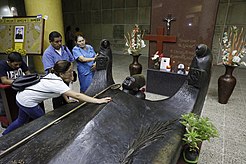
The Constitution of El Salvador guarantees the free exercise of all religions. The same fundamental letter recognizes the legal personality of the Catholic Church, while other churches can obtain, in accordance with the laws, recognition of their personality (art. 26). Historically, the country has had a marked Catholic majority, but according to different surveys this reality has been changing, since in 1995, 16.8% of the population considered themselves Evangelical Christians, while by 2008 the percentage had increased drastically. up to 34.4%; In contrast, the Catholic population is in decline, going from 67.9% in 1995 to 50.4% according to a survey by the José Simeón Cañas Central American University in 2009 (this survey differs in the number of evangelical Christians, estimating them at a 38.2% of the country's population; 2.5% belonged to another religion; while 8.9% claimed to have no religion).
The majority Protestant Christian groups in El Salvador are the churches of the Assemblies of God, Pentecostalism, Baptist Churches, the Presbyterian Church, and the Anglican Church.
Other religions are also present in El Salvador such as Jehovah's Witnesses, Bahaism, Islam, Buddhism, Judaism, groups related to Hinduism, Rosicrucianism, New Age psychic-spiritualist movements and popular religion or syncretic of native traditions and Catholicism.
Holidays
| Date | Name | Description |
|---|---|---|
| 1 January | New Year | Celebration for the arrival of the new year. |
| 16 January | Signature of the Peace Agreements | Celebration of peace agreements. |
| 8 March | Women's Day | Recognition of the Salvadoran woman. |
| 1 May | Work day | Celebration of work in El Salvador. |
| 3 May | Day of the Cross | Celebration of the cross in the form of gratitude. |
| 7 May | Soldier Day | Recognition of the Salvadoran soldier. |
| 10 May | Mother's Day | Recognition of all Salvadoran mothers. |
| 17 June | Father's Day | Recognition of all Salvadoran parents. |
| 22 June | Teacher's Day | Recognition of all Salvadoran educators. |
| 20 July | El Salvadoran Engineer Day | Recognition of all Salvadoran engineers and engineering students. |
| 6 August | Divine Savior of the World | Day dedicated to the Divine Savior of the World, patron of El Salvador. |
| 15 September | Independence Day | Independence of Central America of the Kingdom of Spain. |
| 1 October | Child Day | Festival dedicated to all children. |
| 11 October | Day of the girl | Festival dedicated to all girls. |
| 2 November | Day of the Dead | Celebration of the deceased. |
| 5 November | Day of the First Grain of Independence | Celebration of the first cry of Central American Independence. |
| 2nd Sunday of November | National Pupus Day | Celebration of the traditional food of El Salvador, the pupusas. |
| 24 December | Christmas Eve | Christmas Eve. |
| 25 December | Christmas | Celebration of the birth of Jesus of Nazareth. |
| 31 December | New Year's Eve | Year's Eve. |
* Not all major holidays are holidays.
Contenido relacionado
Snowfall
Mozambique
Atlantic (Colombia)

